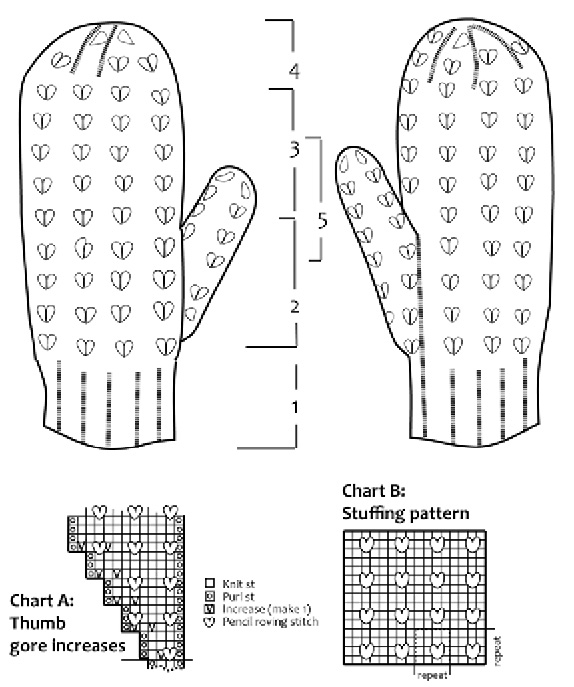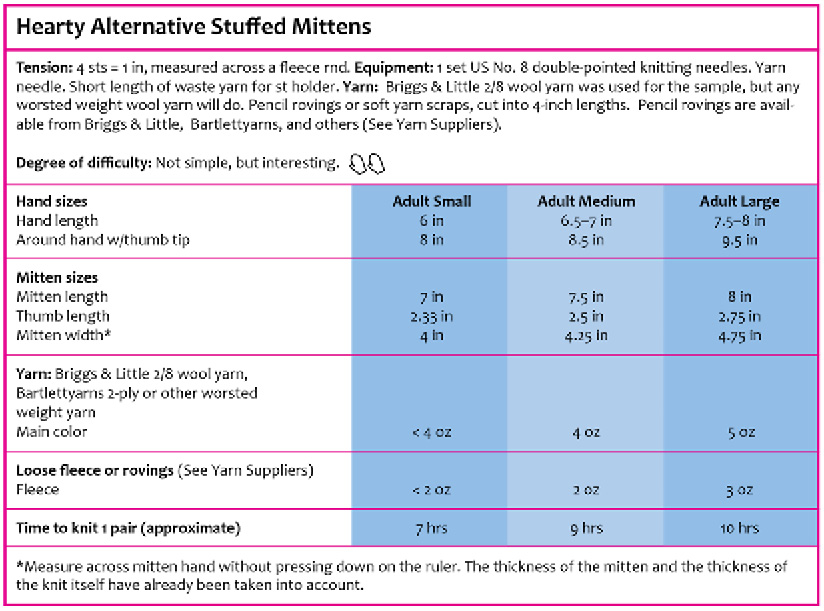Hearty Alternative Stuffed Mittens
New Brunswick
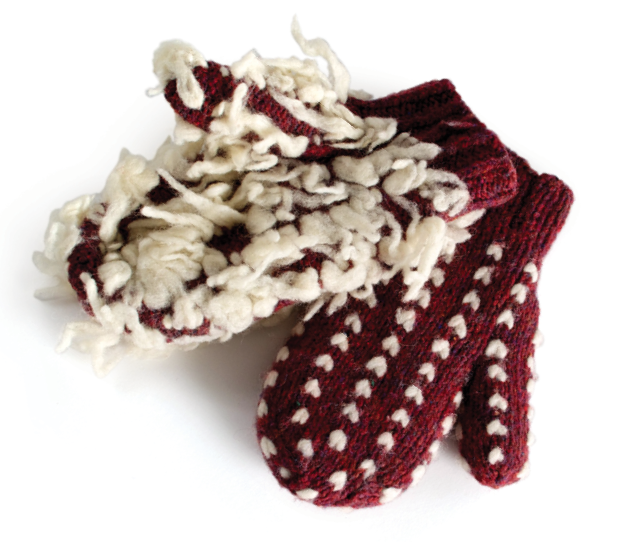
John Little, of Briggs & Little Yarn Company in York Mills, New Brunswick, found this mitten for me. I called him to find a source of pencil roving to make a sample pair of Double-Rolled Mittens for my book, Flying Geese & Partridge Feet.
When I described the mittens to him: They’re knitted, but there are thin strands of yarn on the inside,” he said, “Oh, the women here make piles of them while they’re waiting for the machines.” I hadn’t been able to find anyone who made Double Rolled Mittens at the time, and so the next time I was in New Brunswick—which if you live in Maine is more often than if you live somewhere else—Texas for example—I headed for York Mills to talk to the women who knitted Double Rolled Mittens.
It was a sunny day, but the snow was melting, filling ditches on both sides of the roads to the brim. A couple detours were obviously due to snowmelt topping over into the road. The road became smaller and narrower, and finally turned to gravel, and then ended with a sturdy workman standing next to a boom across the road. Everything beyond looked very wet.
“I can’t go any farther?” I asked.
“You can go through,” he answered with a smile.
“Will anyone come and rescue me if I go off the road?”
“Oh, there’ve been trucks through here all day. But you shouldn’t stop.”
I nodded, and gunned my motor, shot past him into the mire. The road bed underneath seemed to be large round rocks, and I was driving on them, bumping wildly, hardly able to steer, wipers clearing splashed mud from the windshield, muddy water flying past the windows. But I didn’t stop. Ten miles of bumping and mud and thrilling danger, with water continuous into the trees on both sides.
I pulled up onto blacktop, slowed, sprayed the windshield, and hobbled into a gas station for a hosing down. “Some road back there,” I commented to the attendant.
He looked puzzled. “There’s no road back there.”
I arrived at Briggs & Little and met John Little. Nobody knew who Briggs was. John thought collecting knitting patterns was a curious pastime. “Some people collect stamps,” he observed.
How long had the women been knitting Double-Rolled Mittens? Was it a local tradition? I asked.
“Is that what you call them? We called them ‘stuffed mittens.’ They came down from Newfoundland,” he went on. “Via Texas. A woman down in Maine wrote an article in this magazine,” he said, and handed me a copy of an article I had written two years earlier.
Lost, found, and played with: the stuffed mittens introduced in the 1980s as a money maker at Briggs & Little by long time employees Bernette Saunders and Patricia Gass were not the same mitten taught to me by Judy McGrath in Happy Valley, Labrador. Instead of carded fleece, the women stuffed their mittens with bunches of 15-cm long pencil rovings from the mill. The stuffing pattern was tightened to every fourth stitch, every fourth round, and the number of stitches carefully controlled to a multiple of four, so that the inside is evenly covered with fleece.
Instead of little blobs of fleece on the outside, the stuffing stitches look like little white hearts. The women knitted those stitches only with rovings, not locked down with a yarn stitch as on other stuffed mittens. Mittens covered with little hearts—delightful!
I offer Mrs. Gass’s and Mrs. Saunders’ Hearty Alternative for stuffed mittens and hope you will find ways to make them Valentine mittens—or something else calling for hearts.
Technical stuff
Like other mittens I have encountered from eastern Canada, the key number in length (= cuff, thumb, thumb gore, and 1/3 hand length) is calculated not in inches or centimeters but in numbers of rnds, even though that makes the actual length of the cuff shorter. The key numbers for these mittens are 14 (16, 18) rnds.
Briggs & Little 2/8 wool yarn was used for the sample, but Bartlettyarns 2-ply wool yarns will do or any worsted weight wool yarn. Pencil rovings or 4-inch lengths of a lofty, soft yarn will work for the stuffing. Rovings are available from many small mills (See “Suppliers”).
Like many other Canadian mittens, ribbed cuffs and hands are knit on the same size needles. Ribbing usually takes up more room widthwise than stockinette, but the stuffing should bring your tension up to 4 stitches per inch.
Hearty stuffing technique: Insert right needle into st marked for stuffing. Lay the center of two 4-inch strands of pencil roving over the right needle. Knit it off, hanging the loose tails inside the mitten. K the next st normally, passing the yarn over the tails of the roving.
Note: Terms in italic are explained in Techniques and Terms. Please check out T & T at least once, then refer to it when moving into unknown areas. Abbreviations are explained in the directions.
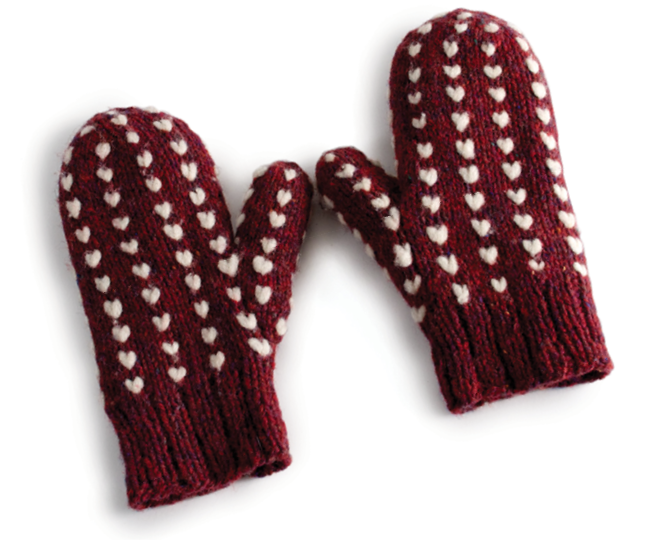
Directions
Abbreviations. dec, decrease; inc, increase; k, knit; p, purl; rnd(s), round(s); st(s), stitches; K 2 tog, knit 2 together. 1. Cuff. On US No. 8 needles, cast on 33 (36, 39) sts. Join and K 2, p 1 for 14 (16, 18) rnds.
2. Lower hand and thumb gore. In 1st rnd, do 2 things: Start thumb gore and begin stuffing.
Round 1. K 2, p 1, k1 stuffed st, inc 1 st by make 1, k 1, p 1. (The 2 p sts continue the p lines from the cuff and will outline the thumb gore.)
Finish rnd in stockinette, following Chart B’s stuffing pattern and the technique directions above. 34 (37, 40) sts
In the next round k around, knitting each roving st with MC yarn. (Maintain the 2 p sts at thumb gore.) If the roving seems to be slipping, give each stuffing st a little tug by its beard as you complete each needle.
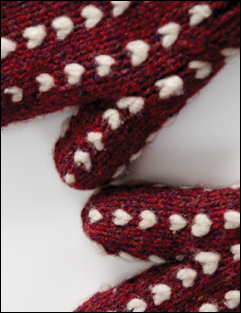
Thumb gore. Maintain the 2 p sts outlining the thumb gore in every rnd.
The remaining incs are all on the left side of the thumb gore, which creates a line of hearts running beside the p marking st on the thumb on one side of the hand and along the purl marker on the hand on the other side.
Every third rnd, inc as follows: K to the last 2 sts before second p st. K 1, make 1, k 1 make 1, p 1 (marker). Consult Chart A, which looks funny, but arranges the fleece hearts logically. Inc by make 1 on the Vs until there are 9 (11, 13) sts between (but not including) the markers.
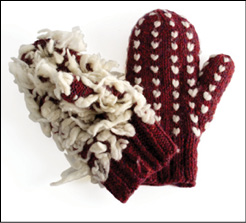
3. Take off thumb. Continue the p sts, but k even until thumb gore is 14 (16, 18) rnds high (as long as the cuff). Place the 9 (11, 13) sts thumb gore sts on a holder and cast on 2 sts over the gap. Discontinue the p marking sts (K them.).
Work even, stuffing all the while, until 3.5 inches above thumb.
4. Dec. Without moving first and last sts in rnd, distribute the sts evenly among 3 needles.
Dec by k 2 tog at beginning of each needle in every rnd (a spiral dec). Dec this way every rnd until 12 to 14 sts will remain in the next rnd. Work next rnd without fleece, then break yarn with 6-inch tail. Using yarn needle, draw up remaining sts on the tail and close the tip.
5. Thumb. On 3 needles, pick up 9 (11, 13) sts from string and 2 sts from above the thumbhole. Pick up and give a half-twist to 1 st in each corner. 13 (15, 17) sts.
Work even on these sts for 12 (14, 16) rnds, then dec as on hand. Finish.
6. Go back to Step 1 and knit another. These mittens are identical and can be worn on either hand.
